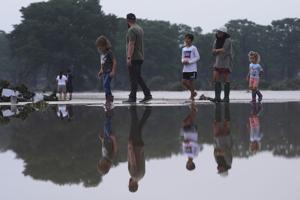
Devastating flash floods unleashed by a powerful storm have claimed at least 51 lives in central Texas, with the hardest-hit area being Kerr County. As rescue operations continue, officials have confirmed 43 fatalities in the region, warning that the death toll is expected to rise. The disaster has also left 27 girls missing, prompting an urgent search across the devastated landscape.
The announcement comes as emergency services work tirelessly to navigate the challenging conditions left in the storm’s wake. The flash floods, which struck with little warning, have caused widespread destruction, sweeping away homes, vehicles, and infrastructure. Local authorities are coordinating with state and federal agencies to manage the crisis and provide relief to affected communities.
Unprecedented Impact on Central Texas
This development follows a series of severe weather events that have increasingly impacted the central Texas region. The current flooding is being described as one of the worst in recent memory, with rainfall levels far exceeding average seasonal expectations. Meteorologists have noted that the intensity and rapid onset of the storm were exacerbated by climate patterns that have been shifting over recent years.
According to sources, the storm dumped over 20 inches of rain in some areas within a 24-hour period, overwhelming rivers and drainage systems. The National Weather Service had issued warnings ahead of the storm, but the sheer volume of water proved too much for existing flood defenses.
Search and Rescue Operations Underway
Meanwhile, search and rescue teams are working around the clock to locate the missing individuals. The 27 girls, reportedly part of a local youth group, were last seen near a campsite that was quickly engulfed by rising waters. Helicopters, boats, and ground crews are scouring the area, hoping to find survivors.
Authorities have urged residents to remain vigilant and heed evacuation orders as more rain is predicted in the coming days. The move represents a critical effort to prevent further casualties and ensure the safety of those in vulnerable areas.
Community Response and Support
In the wake of the tragedy, community organizations and volunteers have mobilized to assist those affected. Local shelters have opened their doors to provide temporary housing and essential supplies. The Red Cross and other humanitarian groups are on the ground, offering support and coordinating relief efforts.
“We are doing everything in our power to bring people to safety and provide the necessary aid to those in need,” said Kerr County Sheriff John Doe at a recent press briefing.
Historical Context and Future Implications
The floods in Texas are a stark reminder of the region’s vulnerability to extreme weather events. Historical parallels can be drawn to the catastrophic floods of 1921 and 1935, which similarly devastated large swaths of the state. Experts warn that such events may become more frequent as climate change continues to alter weather patterns globally.
According to climate scientists, the combination of warmer temperatures and increased atmospheric moisture is likely to result in more intense storms. This poses significant challenges for infrastructure and emergency preparedness in flood-prone areas.
Looking ahead, Texas officials are considering long-term strategies to bolster flood defenses and improve early warning systems. Investments in resilient infrastructure and community education are seen as vital steps to mitigate the impact of future disasters.
As the state grapples with the immediate aftermath of the floods, the focus remains on rescue and recovery efforts. The situation continues to evolve, with authorities providing regular updates on their progress and the ongoing search for the missing girls.






